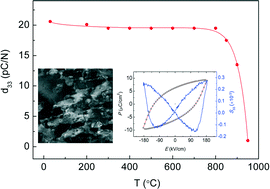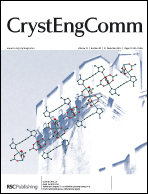A candidate for lead-free ultrahigh-temperature piezoelectrics: the excellent electro-mechanical properties of Aurivillius oxides, Ca1−5xLi2xNd2x□xBi2Nb2−2xScxWxO9−1.5x†
Abstract
Modified ultrahigh-temperature piezoelectric ceramics, Ca1−5xLi2xNd2x□xBi2Nb2−2xScxWxO9−1.5x (CBNO-LiNd-ScW-x, x = 0, 0.01, 0.02, 0.03, 0.04; □ represented A-site vacancies), were synthesized by a traditional solid-state reaction process. XRD Rietveld refinement, TEM, HRTEM and Raman spectroscopy were used to characterize the crystal structures and domain structures of the prepared ceramics. The lithium/neodymium (Li/Nd) and scandium/tungsten (Sc/W) co-substitution as well as the existence of small amounts of A-site vacancies significantly enhanced the ferroelectric and electro-mechanical properties of the CBNO-LiNd-ScW-x ceramics. The Curie temperature (Tc) decreased from 941 °C to 832 °C as the x values increased in CBNO-LiNd-ScW-x, because of an enhancement in the cation disordering between the A site and the bismuth oxide layer. The CBNO-LiNd-ScW-0.01 ceramic with an ultrahigh Tc of 908 °C had a high piezoelectric activity (d33) of 20.6 pC N−1, a large field-induced strain (S33) of 0.27 × 10−3 and a high remnant polarization (Pr) of 6.1 μC cm−2, due to the perfect growth in the ferroelectric domains and the contribution from the reversal of the defect dipoles (VCa′′–VO•• and ScNb′′–VO••); interestingly, it still has a high d33 of 19.5 pC N−1 after up to 800 °C thermal annealing. In addition, the CBNO-LiNd-ScW-0.01 ceramic had a relatively high resistivity of >106 Ω cm at 600 °C and >105 Ω cm at 700 °C.


 Please wait while we load your content...
Please wait while we load your content...